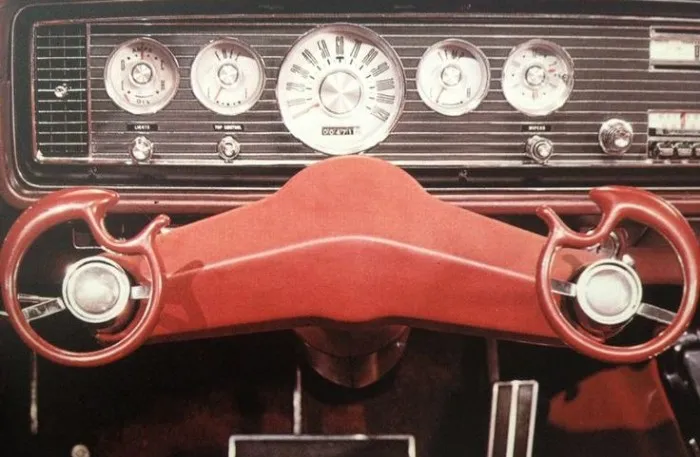The experimental Ford Wrist Twist steering system (1965)
- COCKPIT

- May 31, 2025
- 3 min read

Ford's Mercury brand innovated by creating a wrist-twist system that replaced the steering wheel with two five-inch plastic rings that could be operated by one or both hands. The system was developed by Robert Rumpf, an engineer with a background in missile design.

In 1965, a Mercury Park Lane Convertible rolled slowly along with engineer Bob Rumpf on board. Robert J. Rumpf was a former aerospace engineer. Ford had recruited him to work on experimental concepts. During his career in the automotive industry, he would have 12 patents to his credit. He is notably responsible for the seatbelt retractor. His crowning achievement remains Wrist-Twist Steering. The car did not have a steering wheel but a pair of small dials, like metal bracelets, that you turned to steer left or right. The assembly, which resembled handlebars more than a steering wheel, tilted on its column. This made it easier to access the driver's seat, which defined it as a piece of equipment and not a gadget.
Ford thought of women

Ford is enthusiastic and creates a buzz...in the written press. Smaller than a steering wheel (which used to be king-size at the time), this innovation makes the driver's seat a little more spacious and offers increased visibility. The steering wheel is height-adjustable, which allows for more space when getting in or out of the vehicle. It also lets the driver rest their arms on the armrests attached to the seat. According to Ford, this device is simple and even allows women to use it... Hence the promotional video, with a representative of the fair sex at the wheel of the Mercury who doesn't let herself be fooled! The narrator sells a system that's "as low-tech as possible" and that makes the most complicated maneuver for a woman: "parking." The Wrist-Twist promises to alleviate this stress. So cool, Ford.
“I imagined myself as the first astronaut. I turned on the engine… I was like a nudist in a cactus field…”

At the time, Alex Markovich of Popular Mechanics had the privilege of testing the system. Here's what he had to say about it at the time:
"With the steering rings low on my knees and my elbows resting on the seat's integrated armrests, I felt comfortable but strange. Visibility was splendid, but I missed the steering wheel support. I imagined myself as the first astronaut. I started the engine... I was like a nudist in a cactus field... Every twitch of my wrist triggered an emotion. The car was like a kangaroo, hiccuping at every turn. I pushed down on the rings to turn. The car shuddered embarrassingly... As we approached a corner, I concentrated and told myself, 'Just twist the little rings.'"
The driver control is on par with any current system. The steering ratio is quicker than most American cars (2.8 turns lock-to-lock, compared to 3.6 turns for a standard Mercury).
Despite its strangeness, Markovich eventually took to Wrist-Twist Steering and eventually identified himself as a "Wrist-Twist Steering fan." The hardest part was negotiating parking spaces.

Ford's innovative design had several advantages. Its primary advantage was its size. Because it was smaller than a standard steering wheel, there was more room for visibility and driver adjustability. This design also allowed the driver to rest their arms on an armrest for increased driving comfort. The size and adjustability of the "Wrist-Twist" steering system had the potential to be used to our advantage in our final design. We needed a steering system that would fit into a very small cockpit, but the driver also needed reliable and easy-to-use controls. A drawback to this design was that it would have been difficult to include any type of display or buttons to control the PROVE Lab solar car's throttle.

Ford's "Wrist-Twist" system was designed to improve visibility and facilitate comfort: turning while keeping your arms on the armrests. The good old steering wheel nevertheless endured, arguably less confusing and easier to use than the so-called "wrist-turn" system. Wrist-Twist Steering nevertheless gave Ford an innovative image, and the system was adopted by Chevrolet in 1966 on its experimental Titan III truck.

Mercury has generated reactions to wrist-twist steering from drivers of all stripes. They've let a large number of people drive these cars, and most have commented favorably on the new system's main points. About 200 men and women responded to a questionnaire given to them after their drives, and almost all of them checked the "excellent" column for most aspects. Minor objections have fallen into the comfort domain—the armrests being too high or too low, the ease of getting in and out of the driver's seat, and other minor complaints that would be easily remedied. So, from every practical point of view, the system has already proven itself.



Comments